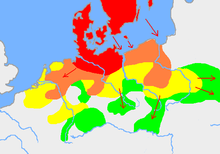Germanic Peoples

Key Terms
edit- Germania[1]-Roman term for the geographical area in north-central Europe inhabited mainly by Germanic peoples.
Key Facts
edit- Proto-Germanic Peoples are believed to have emerged during the Nordic Bronze Age, which developed out of the Battle Axe culture in south Scandinavia.
- By 750 BC, Germanic peoples had spread from the Netherlands to what is now Poland.
- Five Distinct groups of peoples:
- North Germanic: Southern Scandinavia.
- North Sea Germanic: Regions along North Sea and what is now the Jutland Penninsula.
- Rhine-Wesser Germanic: Along the middle of the Rhine and Wesser rivers.
- Elbe Germanic: Along the Elbe River.
- Eastern Germanic: Near the middle of the Oder and Vistula Rivers.
- A group of these Germanic people called the Basternae were the first to come into contact with the Romans. They lived east of the Carpathian mountains by the Black Sea.
- Germanic Peoples eventually made their way into the Crumbling Western Roman Empire during the 5th Century.
- Ostrogoths, Visigoths and Lombards made it into Italy.
- Vandals, Burgundians, Franks, and Visigoths made into Gaul(modern day France and Benelux)
- Vandals and Visigoths also pushed into modern-day Spain(then called Hispania).
- The Alamanni establish some presence in the Alps and Middle Rhine.
- In Denmark, the Jutes merged with the Danes.
- The Geats and Gutes merged with the Swedes in what is now Sweden.
- The Angles merged with the Saxons to create the Anglo-Saxons(now called the English) in modern-day England.
- Odoacer was the commander of the Germanic Mercenaries in Italy, deposed of the last Western Roman Emperor, Romulus Augustulus, in 476 AD.
References
edit- ↑ "History of Germany". Wikipedia. 2018-09-14. https://en.wikipedia.org/w/index.php?title=History_of_Germany&oldid=859517434.